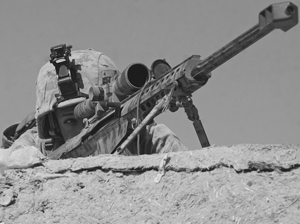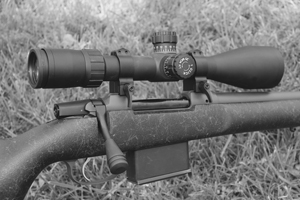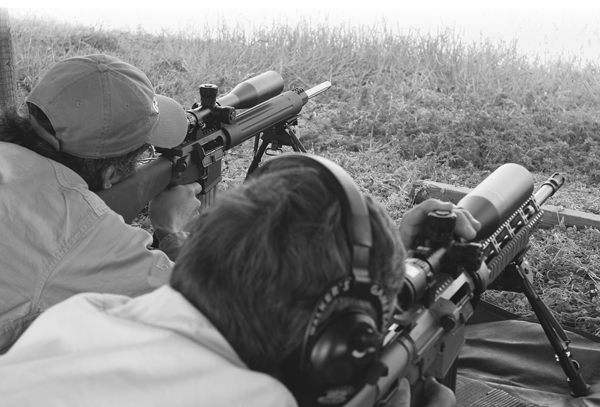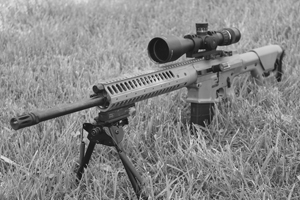

The classic image we have of snipers is that of a lone shooter, or one with a steady companion, waiting in silence in a jungle, or in a ruined building, peering through a scope. Watching patiently, he finally sees his quarry pause, and squeezing the trigger, makes the shot from an impossible distance – so far away that those around the now-retired target don’t know which direction the shot came from, or where to direct their response.
I had a Special Forces trained sniper once tell me “life begins at the triple zero.” Meaning, it was best to work at 1,000 yards or more.
This image has so distorted the reality that just getting things done properly became a problem. For instance, the classic Army and USMC sniper rifle was a Remington bolt gun, called the M40 in the Corps, and the M24 in the Army, chambered in .308. On top was a scope of 10X, 10 power, with a mil-dot ranging reticle in it. With it, the school-trained snipers could estimate range (using the surveying ability of the mil-dot reticle) and poke holes in targets out as far as the bullet was stable. (More on that in a bit.)
Well, when it came time for the police to adopt some kind of counter-sniper rifle, and training, guess what they used as their base? Yes, the .308 bolt gun with 10X scope. Now take a guess, a wild guess, at the average distance of police counter-sniper shots? I’ll wait while you ponder the question. Ready? 53 yards. That’s right, the maximum distance we used to be shooting handguns at, and some still do, is the average for a scoped rifle, from a rest for police. Now, imagine what the field of view is through a 10X scope at 53 yards. Pretty small.
Why such a short distance? A few things: for one, most distances in urban areas just aren’t that far apart. Oh, you can see a building 600 yards away, but SWAT isn’t going to set up a perimeter that far out. They haven’t the manpower. Second, no police chief, sheriff, SWAT commander or watch commander who has to say yes or no to a shot (commonly referred to as “the green light”) is going to give the nod to anything other than a last-moment shot, at the closest possible range. Picking someone off at 600 yards would be quickly followed by a raft of lawsuits (which are going to happen anyway, things being what they are in the modern world) and pilloried for the decision.
Now, that is not always the case. The Texas Tower incident, where Charles Whitman climbed to the top of the bell tower on the U-T/Austin campus, was a long-range affair. He was on the 29th floor observation deck, and he made successful shots out past 400 yards. His efforts were greatly hampered by the residents going home, getting hunting rifles, and returning fire. (I cannot imagine such a thing happening today. The first police to arrive then, joined in.
Today, they’d be arresting those firing back, even if it meant getting shot by the “guy in the tower.” Such is modern life.) But back to the modern police and military perspective: What if you, the police precision marksman, need a follow-up shot? Well, for the military shooter, planning on whacking a general at 1,000+ yards, “follow-up” is anything they do before the chopper picks them up. For a police officer, follow-up is what you need to do before the felon falls to the ground, and still tries to fire the weapon he has in his hands.
When we went into Iraq, things seemed to go as planned. In the wide-open spaces, long range was desired, and snipers were expected to work as they normally would. But one of the things a lot of critics don’t seem to get about combat is the interactive nature of it. It isn’t like a video game, where “level seventeen” is always the same.

A lot of those who think we can create peace, love and understanding by means of talk, good intentions and proper PR seem to think that combat (or law enforcement, for that matter) is like a video game. If you know what will happen on level 17, then you can cruise right through. And each time you have to go through 17 on the way to 18, 19 and 20, the “bad guys” in level 17 will do the same thing. I can only imagine that people with such a child-like view of the world have never even experienced so much as a fistfight in the grade school playground.
Combat is more like football: you go in with a plan. If it works, you keep doing it. If it doesn‘t, you change. If the other guy finds what he’s doing isn’t working, he’ll change. Oh, in the case of a lot of the insurgents, they refused to change, and got shot for their efforts. Ideology, political or religious, can prevent change. But once the stupid or stubborn ones are killed off (and let’s be clear and blunt about this; we’re talking combat) then those that are left will change. Adapt. Find what works, or at least works better.
Which is what happened in Iraq. After standing up and slugging it out, the bad guys figured out that IEDs worked better. So, they started setting bombs. Our guys adapted by changing the doctrine of how snipers worked.
Previously, snipers worked in two-man teams. (And, lest you think I’m revealing state secrets, this is common knowledge amongst those who pay attention.) They worked for commanders higher in the food chain than platoon or company commanders.
Even battalion honchos were out of the loop at times. Snipers early on were viewed as being just as valuable if they saw and reported good intel as they were if they whacked bad guys. A sniper who is “working for” the regimental commander won’t even have a way to talk to the company commander whose area he’s “hunting in.” Barring an emergency, or a need to not get shot at by his own guys, the sniper would not even talk to, or be known to, the company commander.
The Iraqi-based bad guys started setting IEDs, and snipers went out with the idea of getting into a good “hide” and either shooting or reporting on the bomb setters. Well, when you’re out there on your own, two-man teams are less than optimal. In fact, they’re stupid. Two guys can’t watch the possible bomb sites and simultaneously watch their own backs. And if the bad guys come for them (someone spotted them, someone figured out the likely locations for hides, etc.) two guys can’t hold off more than a handful of attackers. Especially if one of them has a bolt-action M40/24.
Because bolt guns are slow. Oh, a trained bolt-gunner can fire 10 aimed shots in 70 seconds at Camp Perry, but that didn’t help. You see, school-trained snipers aren’t trained to work a bolt as if they were on the line at Perry. And 70 seconds is forever. If a team shows up to set a bomb, you want to bag them all, not just one or two. A bolt-gunner can get one, maybe two if they are far from cover. If someone has you under fire from an adjacent building while their buddies are assaulting up the staircase that is your exit, 70 seconds may be the rest of your life. As a result, there is a big push in the services for a semi-automatic sniper rifle and for bigger sniper teams.

You see, the bad guys were no dummies. An IED wasn’t just a-guy-with-a-shovel-and-a-satchel affair. Proper location mattered. So, once they’d scouted out a good spot, there would be a team on the job: the explosives expert (or what passed for one, given the time and place), the digger or diggers, the security team, spotters and so on. Anywhere from four to 10 guys. Clearly, it would be expeditious to bag all of them. That way, the skilled/experienced ones will be removed from the lists, to be replaced by less-experienced ones. Also, it becomes a lot more difficult to recruit new bomb-team members, if each time a team gets “made” they all get shot.
Now, on the sniper end of things, it becomes more difficult and involved. First, you can’t send out just a two-man team. Once things shifted to a sniper-vs.-bombers basis sending two-man teams out was a good way of ensuring they didn’t come back.
So, it became a team job. A team would be three or more pairs of sniper-spotters with another handful of security members. You could have a dozen men trying to sneak through the streets, set up, and watch unobserved, to cover a likely bomb area or areas. The bigger the group, the more difficult it was to insert the team and pass unnoticed. And the team needed a bigger area, as you couldn’t just pack a dozen guys (and all their gear) into a small corner room of an apartment building.
The snipers also had another problem: gear. If you’re going to whack bad guys at distance, you need a bolt gun with a 10X scope. (And remember, the guys doing this were limited to the tools in inventory. No fair in saying “they should have been using XYZ rifle. The government didn’t have any.) But an M24 is not what you need if the team gets spotted on the way in and you find yourself in a fight to extricate yourselves from the mess. For that you need an M4. So, what to do? Pack everything? An M24, ammo, spotting scope, shooting mat, etc. and an M4 with a go-bag full of loaded magazines? Even if you’re a twenty-something trooper in peak physical condition, that’s a lot of stuff to be humping.
So a semi-auto sniper rifle becomes very attractive. Especially if you can swap uppers. For the insertion part, you’d be cat-footing in with a 14.5-inch .308 rifle and an Aimpoint or EOTech on it. The short length and the no-magnification optics mean you’d be using a fast and nimble hammer on the tangos across the street, the ones who stumbled into your team while you were heading to the objective. If you don’t get spotted and you make it to your intended area, you have time to set up. Once in place, you take that upper off, and pull the 20-incher with 10X scope upper out of your rucksack. Now you’re set to get the job done at 600 yards and more.

Now, this is not a problem that is new. When the repeating rifle with smokeless powder, was new, suddenly riflemen had range. They could dependably hit a man-sized target at impressive distances (on the target range, anyway) compared to what the black powder rifles of the time could do.
As a result, rifles were set up for distance. Common military sights of the time, when set at their lowest setting, would produce bullet impacts 6 to 8 to 10 inches over the point of aim at 100 yards. The idea was simple: hold your sights on the belt buckle of the opposing soldier, and at any distance out to combat maximum, in some cases well past 400 yards, you’d get a hit. Beyond that, you’d then adjust your sights for range.
In WWI, with the trenches 100 yards apart or so, you have to figure a lot of soldiers were guessing as to how much under they had to hold, to get a hit.
Even in WWII, with a lot of wide-open areas, most engagements were at relatively close distances. Much sniper work was done in the ruins of the various cities on the Eastern Front, as the Soviets pushed the Germans back. Even when the fight was in the wide open steppes, the shots were often just a few hundred yards or less, since the first order of getting a decisive shot is to spot the target. If you can’t see him, you can’t shoot him. It is rare that range becomes the only issue in the mix of variables.
In another instance of the interactive nature of combat, Major Thomas Ehrhart in his monograph “Increasing Small Arms Lethality in Afghanistan” reports on the adaptation of the Taliban combatants. The average US soldier is not trained to shoot beyond 300 meters.
That’s the maximum distance of the computer-controlled pop-up targets he or she shoots at. (Marines shoot on ranges longer than that, but only to 500 meters.) Worse yet, since a soldier only gets 20 rounds for 20 targets in the qual course, they are routinely told to ignore the 300- and 275-meter targets and save those shots for the closer targets to ensure a hit, and thus a passing score. (Passing is 12 out of 20, or 24 out of 40), so a Taliban at 400 meters is relatively safe from most Army shooters.
The minimum distance at which artillery, air strikes, naval gunfire (probably not an issue in Afghanistan) or a Spectre gunship can fire is not as close as you’d think. As a courtesy to those providing indirect fire support, the requester will mention when things are particularly troublesome at the moment, with bad guys at a close range: the fire request will include the term “danger close.” Basically that means “For what you’re sending, we’re at or inside the minimum safe distance the field manual calls for. Please be careful.”
How close is “close?” Well, the calculated minimum (it involves the average dispersion of fired rounds, the distance fired, the standard deviation of fragment spread and distance traveled, and for all I know, the phase of the moon) are listed in various field manuals. What I’ve been advised are working distances are as follows:
M203 & Mk19 100 meters
60mm mortars 200 meters
81mm mortar 300 meters
120mm mortar 600 meters
105mm 750 meters
155 & larger 1,000 meters
You’ll note that while the organic firepower that a squad, platoon or company might posses will cover past the 300 meter range, the larger stuff leaves a gap. Also be aware of a small detail, but an important one: the minimum safe distance depends to a certain degree on the distance to the artillery battery, i.e., time of flight.
The longer a projectile is in the air, the longer air currents can work on it. A mortar firing “charge zero” (the minimum the things will fly) will be dropping shells only a hundred yards or more downrange. For that, “danger close” could be 20 yards, if you really trust the mortar gunner to know his stuff. Time of flight is just a few seconds. A big gun, such as a 155mm, or an eight-inch howitzer, can have a flight time of more than a minute at their maximum range. For that transit time, you want to have them start far out, and work their way closer.
Now, the calculated safe minimum instance, and the one actually in effect by careful troops who are depending on well-trained support is a lot less. But you still won’t see 155s coming in on a hilltop 5-600 meters away, not on a regular basis, not first rounds, and not unless it is a real emergency.

There’s also the matter of time. If a savvy small unit leader has planned ahead, he will have already picked likely hilltops and such on the map, places that might be useful to shoot at his unit. If he has done so, and coordinated with the local artillery battery, they can speed things up. The artillery battery can have the guns laid on each position in sequence, as the infantry unit approaches it. They can have pre-calculated the firing solution and have rounds one step from ready. If he does that (and the artillery unit is willing to go to the constant work involved) he can easily have shells on target starting one minute after calling for fire.
If he hasn’t, but the battery is ready and waiting, and he has a good forward observer, the first ones will hit in three or four minutes, and adjusted and hammered soon after. From a cold start, with guns not registered, and scrambling to re-lay the gun, it can be 10 minutes or more before you have hot steel raining down on your problem du jour.
One minute is a long time, four an eternity. If the Taliban are smart (and at least some of them have to be) then a smart guy will have his ambush team fully trained and instructed. In one minute, an ambusher can have two full belts downrange from each machine gun, two or three rounds from each RPG, and half a dozen or more rounds from a 60mm mortar. And then be packing and boogeying off the ridgeline before the first artillery round is incoming. Four minutes? He’s out of the severe hazard zone, and almost in the next zip code.
Now, there’s one wrinkle for the bad guys in this disparity between safe distance and ordnance: the Spectre gunship. For those who don’t know about it, it came about as an improvement over “Puff the Magic Dragon” in Vietnam. That was a C-47 with a row of machine guns (later, miniguns) pointing out the windows. The pilot would bank around a particular spot, and trigger the guns, and be firing a whole row of machineguns that would pour rounds into the area.

The Spectre is simply a C-130 with miniguns, 25mm, 40mm cannons and a 105mm howitzer pointing out the left side. And as a vast improvement over the C-47, the C-130 pilot banks but the gun crew use video monitors to precisely refine aim and place shots where they need to be. I have heard from those who have been there that a Spectre can place its shots safely (after all, the distance involved is almost inconsequential by artillery terms) as close at 50 meters. That is, a circling Spectre can put a 105mm shell right through the window of the building across a boulevard from your position.
You’re probably thinking “This means we can drop explosives where we want.” Yes – but. The max speed of a C-130 is 260 knots (299 mph). However, it isn’t going at max while banking and hammering. The speed there (it depends on altitude, gross weight, etc. ) is more like 150-175 mph. Which means it is a big, fat, slow-moving target for surface-to-air missiles. As a result, use of the C-130H and C-130J models are restricted to night-time use in Afghanistan.
Once they figured out there was a gap, the Taliban took advantage of this gap. Inside the artillery or air strike danger zone, but outside of the effective rifle fire, the Taliban had only to worry about belt-fed machineguns, and the 7.62 ones at that. Yes, a sniper rifle would be very helpful, but it isn’t exactly an even match: a bolt-action sniper rifle with a five-round magazine, vs. a belt-fed 7.62, on a tripod, at 800 meters, with belts of ammo ready, and a spotter to call the range.
Again, a semi-auto sniper rifle would be very useful in those instances.
You might be asking “Why not pack the mortars or grenade launchers?” Simple: they weigh a lot and can’t be man-packed across much of a distance. The M224 60mm mortar, bipod, baseplate, tube and sight weighs 46.5 pounds, and each round weighs 3.75 pounds. The three-man crew can’t carry it and any significant amount of ammo as well. So, if you plan on having a mortar and 20 rounds with you, you have to figure out how to pack an additional 150 pounds, once you account for the mortar and gear, plus the ammo and their packing tubes. (You do not pack bare mortar shells in your gear. Pack it in the storage tubes, or prepare to be shunned by all.)
So you need an additional vehicle to haul the crew and mortar. Or a dedicated mortar team.
Now, imagine a Taliban commander, watching an approaching American convoy of up-armored Humvees. If he knows what the one with the mortar crew looks like, that’s the one he’ll instruct his best machine-gun crew to work over first. If not, as soon as he spots the crew setting up, guess who gets his attention? Ditto the vehicle armed with a Mk 19 grenade launcher. And if the convoy looks too tough, he’ll just let them pass and clobber the next one.
And none of this helps a patrol on foot.
My apologies for giving you so much info on mortars, artillery and such, but I think it is important to understand the context in which the modern sniper works these days.
The US armed forces have been using a semi-auto for a while; the M110, a .308 semi-auto, also known as the Knight’s SR-25, a descendant of the AR-10. While loved by some, it is also the recipient of some criticism. Across the Atlantic, the British recently adopted the L129A1, made by LMT.
Now, the effectiveness of a system is not just a matter of features, specs and cost. Training matters. In many instances, training can matter more than gear. But, being the gearheads we are, we spend a lot of time looking at gear and features.
This article is an excerpt from the Gun Digest Book of the Tactical Rifle. In Part II Patrick Sweeney will range test and review some of his favorite semiautomatic sniper rifles. Click here to read Part II

Next Step: Get your FREE Printable Target Pack
Enhance your shooting precision with our 62 MOA Targets, perfect for rifles and handguns. Crafted in collaboration with Storm Tactical for accuracy and versatility.
Subscribe to the Gun Digest email newsletter and get your downloadable target pack sent straight to your inbox. Stay updated with the latest firearms info in the industry.







